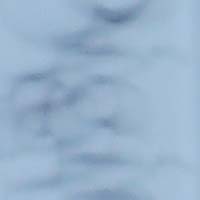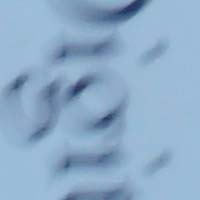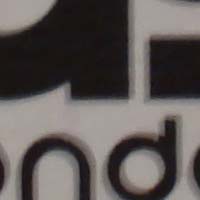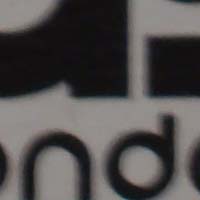Sony Cyber-shot DSC-W200 Review
Review Date: January 28th 2007
Author: Mark Goldstein
Leave a comment about this Review
|
Image Quality
All of the sample images in this Review were taken using the 12 megapixel JPEG setting, which gives an average image size of around 4Mb.
Noise
There are 6 ISO settings available on the Sony Cyber-shot DSC-W200 which you can select at any time if the camera is in the Program or Manual shooting modes. There is no discernible noise at the slowest setting of ISO 100, but noise and slight loss of detail is already apparent at ISO 200, particularly in the shadow areas. At ISO 400 image quality has deteriorated quite a lot as the camera blurs detail to try and hide the noise, and ISO 800 is an emergency option only. The fastest speeds ISO 1600 of 3200 seem to have been included to make the spec sheet look good, and should really be avoided at all costs. Here are some 100% crops which show the noise levels for each ISO setting:
ISO 100 (100% Crop) |
ISO 200 (100% Crop) |
 |
 |
ISO 400 (100% Crop) |
ISO 800 (100% Crop) |
 |
 |
ISO 1600 (100% Crop) |
ISO 3200 (100% Crop) |
 |
 |
Sharpening
Here are two 100% crops which have been Saved as Web - Quality 50 in Photoshop. The right-hand image has had some sharpening applied in Photoshop. The out-of-the camera images are just a little soft at the default sharpening setting, with further sharpening in a program like Adobe Photoshop not really neccessary. You can change the in-camera sharpening level if you don't like the default results.
Original
(100% Crop) |
Sharpened (100% Crop) |
 |
 |
 |
 |
Chromatic Aberrations
The Sony Cyber-shot DSC-W200 suffered from some obvious chromatic aberrations, especially purple frining, although the effects only really appeared in areas of high contrast, as shown in the examples below.
Example
1 (100% Crop) |
Example
2 (100% Crop) |
 |
 |
Macro
The Sony Cyber-shot DSC-W200 offers a Macro setting that allows you to focus on a subject that is 5cms away from the camera. The first image shows how close you can get to the subject in Macro mode (in this case a compact flash card). The second image is a 100% crop.
Macro Shot |
Macro Shot (100% Crop) |
 |
 |
Flash
The flash settings on the Sony Cyber-shot DSC-W200 are Auto, Forced Flash, Slow Syncro and No Flash with Red-eye Reduction available as a main menu option. These shots of a white coloured wall were taken at a distance of 1.5m.
Suppressed Flash - Wide Angle (35mm) |
Forced Flash - Wide Angle (35mm) |
 |
 |
Suppressed Flash - Telephoto (105mm) |
Forced Flash - Telephoto (105mm) |
 |
 |
And here are some portrait shots. The Auto setting caused some quite obvious red-eye, which the Red-eye reduction mode replaced with slight green-eye!
Auto |
Auto (100% Crop) |
 |
 |
Red-eye reduction |
Red-eye reduction (100% Crop) |
 |
 |
Night Shot
The Sony Cyber-shot DSC-W200's maximum shutter speed is 30 seconds in the Manual shooting mode, which is excellent news if you're seriously interested in night photography. The shot below was taken using a shutter speed of 25 second, aperture of f/5.6 at ISO 100. I've included a 100% crop of the image to show what the quality is like.
Night Shot |
Night Shot (100% Crop) |
 |
 |
Anti Shake
The Sony Cyber-shot DSC-W200 has an anti-shake mechanism, which allows you to take sharp photos at slower shutter speeds than other digital cameras. To test this, I took 2 handheld shots of the same subject with the ISO speed set to 100. The first shot was taken with anti shake turned off, the second with it turned on. Here is a 100% crop of the image to show the results. As you can see, with anti shake turned on, the images are sharper than with anti shake turned off. This feature really does seem to make a difference and could mean capturing a successful, sharp shot or missing the opportunity altogether.
| Shutter Speed / Focal Length | Anti Shake Off (100% crop) |
Anti Shake On (100% crop) |
| 0.3 sec / 105mm |  |
 |
| 1/10th sec / 70mm |  |
 |
Overall Image Quality
The Sony Cyber-shot DSC-W200 produced images of below average quality during the review period. It offers an extensive ISO range of 100-3200, but only ISO 100-200 is really usable, with noise appearing at the relatively slow speeds of ISO 200 and 400, and lots of noise and blurring of detail at the higher ISO speeds of 800 and faster. Chromatic aberrations appeared in more shots than I would have liked, with some obvious purple fringing effects appearing in high contrast situations. Macro performance is just about average, allowing you to focus as close as 5cms away from the subject. The built-in flash worked well indoors with good overall exposure, and the W200's Red-eye Reduction setting also reduced the effects of red-eye quite effectively, albeit replacing it with a subtle green halo. The night photograph was excellent, with the maximum shutter speed of 30 seconds providing lots of potential for creative night photography. The 12 megapixel images are very slightly soft straight out of the camera, so they don't require further sharpening in an application like Adobe Photoshop. The anti-shake system worked well to reduce the effects of camera-shake at slower shutter speeds. Overall a fairly disappointing performance from the Sony Cyber-shot DSC-W200.
|
![]() PhotographyBLOG
is a member of the DIWA
organisation. Our test results for the Sony Cyber-shot DSC-W200 have been submitted to DIWA
for comparison with test results for different samples of
the same camera model supplied by other DIWA
member sites.
PhotographyBLOG
is a member of the DIWA
organisation. Our test results for the Sony Cyber-shot DSC-W200 have been submitted to DIWA
for comparison with test results for different samples of
the same camera model supplied by other DIWA
member sites.
